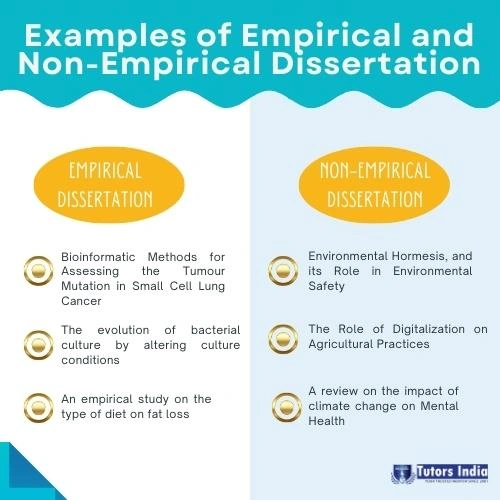What is the length of empirical and non empirical dissertations? Cite some examples from biological and life sciences domain
Master’s dissertations are a crucial part of a Master’s degree. Students may be asked to do various types of dissertations, depending on their speciality and research objective. However, the most common types of dissertations are empirical dissertations and non-empirical dissertations.
What is an empirical dissertation?
- An empirical dissertation is one that deals with collecting and analysing original data. The original data is also called primary data.
- A systematic approach to research methodology is followed for developing research questions, selecting study subjects, data collection and data analysis in an empirical dissertation.
- The research methods involved in an empirical dissertation include surveys, interviews and observations. Empirical research methods are commonly used in social science and science.
What is the length of an empirical dissertation?
- The length of an empirical dissertation can vary depending on the specific guidelines set by the university and the discipline.
- Generally, an empirical dissertation in the UK can range from 10,000 to 15,000 words for a bachelor’s degree, 15,000 to 20,000 words for a master’s degree, and 60,000 to 100,000 words for a doctoral degree.
- The dissertation guidelines regarding the length of a dissertation may differ depending on the university and the specific requirements of the program. It is important to check the guidelines provided by the university and the department to ensure that the dissertation meets the required length and format (Button, 2020).

What is a non empirical dissertation?
- Non empirical dissertations are those that deal with critically analysing literature from previous research and policies.
- No original or primary data is collected in a non empirical dissertation. Data from previous research is used instead for analysis. This data is known as secondary data.
- Non empirical dissertations are commonly used in fields like literature and arts.
What is the length of a non empirical dissertation?
- Like the empirical dissertation, the length of a non empirical dissertation differs depending on the specific requirements of the academic institution and the program of study.
- Generally, non-empirical dissertations are shorter than empirical dissertations and typically range from 15,000 to 25,000 words.
- However, checking with your academic supervisor or program guidelines for specific requirements is essential (Ullah, 2018).
Examples of empirical and non-empirical dissertations in Biology and life sciences
The field of biological and life sciences is vast and may involve empirical and non empirical dissertations, depending on the research question.
The following are empirical dissertation examples in biology and life sciences:
- “Bioinformatic Methods for Assessing the Tumour Mutation in Small Cell Lung Cancer: An Empirical Study” by Karl Cooper. This study deals with the application of bioinformatic methods that assess how Tumour Mutation Burden can be used to detect Small Cell Lung Cancer.
- “ The evolution of bacterial culture by altering culture conditions: An Empirical Study” by Catherine Packard. This study explores how selective media helps identify and isolate strains that require specific conditions to grow.
- “ An empirical study on the type of diet on fat loss” by Maria Karpov. Many types of diet are available: Keto, Intermittent fasting and Carb cycling, and this study seeks to determine which diet is best suited for fat loss.
- “An analysis of the development of Antimicrobial Resistant Strains in St. Louis Hospital: An Empirical Study” by James Robinson. Antimicrobial resistance (AMR) is a serious health concern, and this study deals with studying the development of antimicrobial strains in a hospital.
- “ An empirical study of physiological and physical characteristics in car racers” by Diane Rodriguez. This study delves into the physiological and physical characteristics of car racers and how they are different from sedentary individuals.
The following are non empirical dissertation examples in biology and life sciences:
- “Environmental Hormesis, and its Role in Environmental Safety: A non-Empirical Study”; by Clare Shilling. This dissertation strives to clarify the concept of environmental hormesis and how it ensures environmental safety. This dissertation uses non empirical methods, including a review of existing literature and theoretical analysis.
- “The Role of Digitalisation on Agricultural Practices: A Non-Empirical Study” The main focus of this dissertation is to explore the impacts of digitalisation on agricultural practices and how digitalisation can shape the future.
- “ A review on the impact of climate change on Mental Health: A Non-Empirical Study” by David Spencer. This dissertation studies the available literature and analyses how climate change can influence mental health.
- “The interpretation and decline of major insect species: A Non-Empirical Study” by Martha Schneider. This study examines the factors that led to insect decline, how it could impact the environment and what measures could be implemented to prevent further decline.
- “A Non-Empirical study exploring the complex molecular genomics of familial hypercholesterolemia” by Chris Hiddleson. This study discusses the various genes that contribute to the development of hypercholesterolemia and how the condition can be detected in asymptomatic individuals.
To know more about how a dissertation is written in life sciences, check out our example on Enhancing Undergraduate Medical Education through Simulation: A Pathway to Realistic Clinical Training.
Non empirical dissertation examples in other fields:
Some examples of non-empirical dissertations in other fields are:
- A theoretical analysis of the concept of Justice in Political Philosophy
- An exploration of the history and development of literary genres in English literature
- An Examination of the Role of Technology in shaping modern marketing strategies
- A Critical review of the effectiveness of cognitive behavioural therapy in treating anxiety disorders
- A study of the ethical and legal considerations surrounding artificial intelligence in the field of computer science
Check out our dissertation examples to know how a dissertation is written in various fields.
Conclusion
There are many types of dissertations, and empirical and non empirical dissertations are the most common ones. Empirical dissertation deals with collecting original data from study participants, while non empirical dissertations deal with obtaining data from previously conducted research, synthesising the information and drawing inferences. The choice of selecting type depends on the objectives and the research questions.
About Tutors India
We are a team of academic experts and Researchers who assist Master’s students with dissertations. Our diverse team enables us to help students mastering in various fields. We offer part or full dissertation help and assist students at every step of the dissertation process, be it choosing a dissertation topic, drafting a research proposal and helping with research methodology, dissertation plan, data collection and statistical analysis. We also offer technical editing services and help students with resit dissertation, ensuring their dissertation follows the university specifications and is error- and plagiarism-free.
For more guidance on what key points to consider while resubmitting the Master’s dissertation, check out our study guide.
References
Button, K. S., Chambers, C. D., Lawrence, N., & Munafò, M. R. (2020). Grassroots Training for Reproducible Science: A Consortium-Based Approach to the Empirical Dissertation. Psychology Learning & Teaching, 19(1), 77–90. https://doi.org/10.1177/1475725719857659
Ullah, A., & Ameen, K. (2018). Account of methodologies and methods applied in LIS research: A systematic review. Library & information science research, 40(1), 53-60. https://doi.org/10.1016/j.lisr.2018.03.002.

 Next Post
Next Post